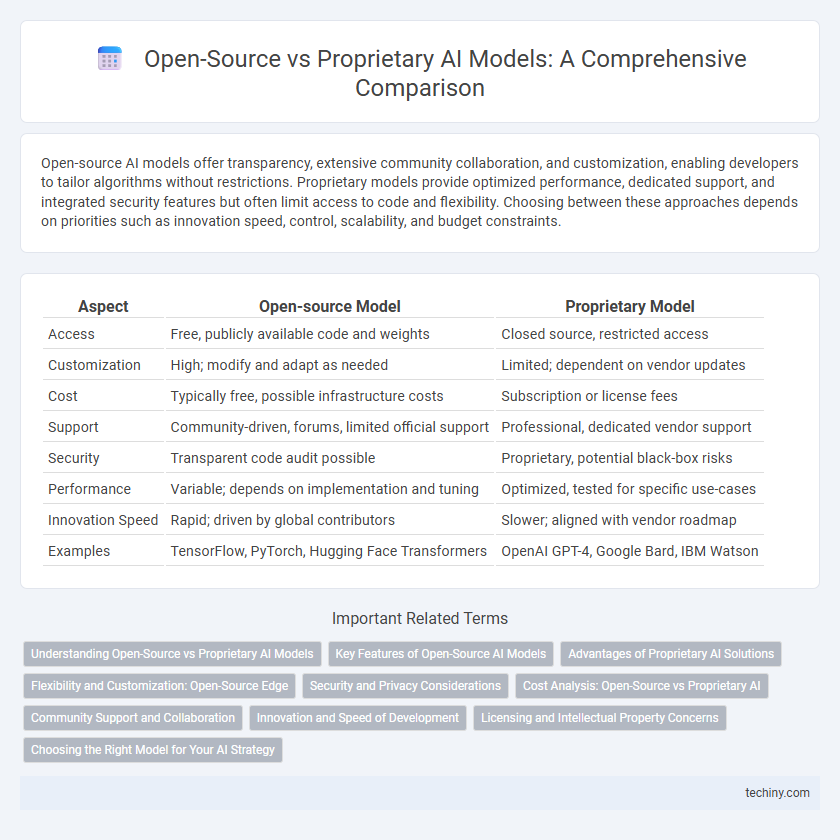Open-source AI models offer transparency, extensive community collaboration, and customization, enabling developers to tailor algorithms without restrictions. Proprietary models provide optimized performance, dedicated support, and integrated security features but often limit access to code and flexibility. Choosing between these approaches depends on priorities such as innovation speed, control, scalability, and budget constraints.
Table of Comparison
| Aspect | Open-source Model | Proprietary Model |
|---|---|---|
| Access | Free, publicly available code and weights | Closed source, restricted access |
| Customization | High; modify and adapt as needed | Limited; dependent on vendor updates |
| Cost | Typically free, possible infrastructure costs | Subscription or license fees |
| Support | Community-driven, forums, limited official support | Professional, dedicated vendor support |
| Security | Transparent code audit possible | Proprietary, potential black-box risks |
| Performance | Variable; depends on implementation and tuning | Optimized, tested for specific use-cases |
| Innovation Speed | Rapid; driven by global contributors | Slower; aligned with vendor roadmap |
| Examples | TensorFlow, PyTorch, Hugging Face Transformers | OpenAI GPT-4, Google Bard, IBM Watson |
Understanding Open-Source vs Proprietary AI Models
Open-source AI models provide transparency, enabling developers to access, modify, and improve the underlying code, fostering innovation and community collaboration. Proprietary AI models, owned by corporations, offer specialized features and optimized performance but restrict access to the source code, limiting customization and external validation. Understanding the trade-offs between openness and control is crucial for selecting AI models aligned with organizational goals and data privacy requirements.
Key Features of Open-Source AI Models
Open-source AI models offer transparency and flexibility by allowing developers to access, modify, and distribute the underlying code, fostering collaboration and innovation. These models typically provide extensive customization options, enabling integration with diverse applications and rapid experimentation without licensing restrictions. Community-driven development ensures continuous improvement, robust security through peer review, and cost-effective deployment, distinguishing open-source AI from proprietary counterparts.
Advantages of Proprietary AI Solutions
Proprietary AI solutions offer enhanced security through controlled access and rigorous data privacy measures, ensuring sensitive information remains protected. These models benefit from specialized support and continuous updates, providing reliable performance and integration tailored to specific business needs. Exclusive access to proprietary algorithms can lead to competitive advantages by enabling unique functionalities not available in open-source alternatives.
Flexibility and Customization: Open-Source Edge
Open-source AI models provide unparalleled flexibility and customization opportunities, enabling developers to modify codebases to fit specific use cases and innovate rapidly. Proprietary models often restrict access to underlying algorithms, limiting adaptability and integration with existing systems. The open-source edge fosters collaborative improvements and tailored AI solutions, ensuring scalability and alignment with diverse organizational needs.
Security and Privacy Considerations
Open-source AI models provide transparency that allows independent security audits and community-driven vulnerability identification, enhancing trust and collaborative improvements in privacy safeguards. Proprietary AI models restrict access to source code, which may obscure potential security flaws and complicate external privacy assessments, but they often invest heavily in controlled environments and internal protections. Organizations must weigh the benefits of open scrutiny against the assurances of proprietary oversight when prioritizing security and privacy in AI deployment.
Cost Analysis: Open-Source vs Proprietary AI
Open-source AI models offer significant cost advantages by eliminating licensing fees and enabling community-driven improvements, reducing development and maintenance expenses. Proprietary AI models often involve substantial upfront licensing costs and ongoing subscription fees but provide dedicated support and optimized performance tailored to specific business needs. Evaluating total cost of ownership, including infrastructure, customization, and scalability, is crucial for organizations choosing between open-source flexibility and proprietary reliability.
Community Support and Collaboration
Open-source AI models benefit from extensive community support and collaborative development, enabling rapid innovation and transparent improvements. Proprietary models, while often backed by dedicated in-house teams, lack the diverse input and shared resources found in open-source ecosystems. Community-driven projects foster knowledge exchange and collective problem-solving, accelerating the evolution of AI technologies beyond the scope of proprietary counterparts.
Innovation and Speed of Development
Open-source AI models accelerate innovation by enabling collaborative development, rapid experimentation, and widespread knowledge sharing, fostering a dynamic ecosystem of improvements. Proprietary models often prioritize controlled environments and intellectual property protection, which can slow iteration but ensure stability and tailored optimization. The open-source approach typically leads to faster development cycles and diversified innovation driven by a global community of developers and researchers.
Licensing and Intellectual Property Concerns
Open-source AI models provide transparent access to code and data, encouraging collaboration and innovation while requiring adherence to specific licensing agreements like Apache or GPL that govern usage and distribution. Proprietary models restrict access through exclusive licensing, protecting intellectual property but limiting user modification and wider integration capabilities. Licensing frameworks critically impact deployment options, compliance requirements, and the safeguarding of proprietary advancements in AI technology.
Choosing the Right Model for Your AI Strategy
Selecting the right AI model hinges on assessing project goals, budget constraints, and desired control levels. Open-source models offer transparency, flexibility, and community support, making them ideal for customization and innovation. Proprietary models provide robust performance, dedicated support, and streamlined integration, suitable for businesses requiring reliable, ready-to-use solutions.
Open-source Model vs Proprietary Model Infographic

 techiny.com
techiny.com